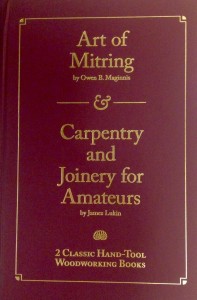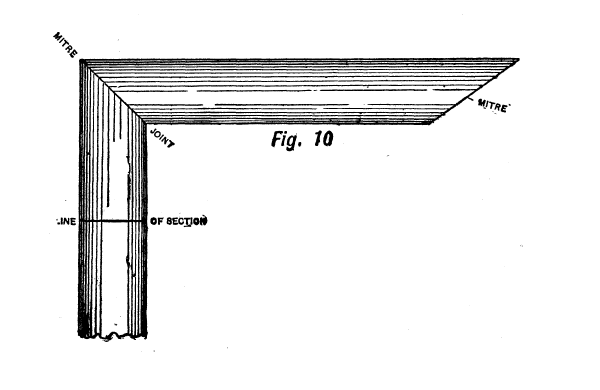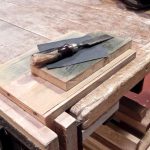We may receive a commission when you use our affiliate links. However, this does not impact our recommendations.
Woodworking is a craft steeped in knowledge handed down through generations. The techniques have been tested and rethought and retested time and time again. While experimentation is a wonderful thing for the craft, there is simultaneously a good deal of importance in attention to detail and being exact. Learning the old ways and time-tested woodworking techniques is important. Once you have a good foundation you can be creative with your craft and explore wherever the wood takes you.
 Enter two fantastic, classic texts “The Art of Mitring” (or “How to Join Mouldings” or, “The Arts of Mitring and Coping”) by Owen B. Maginnis and “Carpentry and Joinery for Amateurs” by James Lukin. These two books have been favorites of woodworkers for more than a century because the information in them quite simply stands the test of time.
Enter two fantastic, classic texts “The Art of Mitring” (or “How to Join Mouldings” or, “The Arts of Mitring and Coping”) by Owen B. Maginnis and “Carpentry and Joinery for Amateurs” by James Lukin. These two books have been favorites of woodworkers for more than a century because the information in them quite simply stands the test of time.
Some aspects of woodworking will never change no matter what new machines, tools or jigs are used to accomplish them. Maginnis begins his book with the definition of a miter (or mitre) – a thing that will always be what it is:
“Mitre” is defined architecturally by Webster as the “joint formed by two pieces of moulding each cut at an angle and matching together; to meet and match together on a line bisecting the angel of junction, especially when at a right angle; to cut the ends of two pieces obliquely and join them at an angle.”

This definition is an example of the mindset needed. Often times we simply must acknowledge that something “is what it is.” A measurement is a truth. If you attempt to fudge it or fake it there will undoubtedly be consequences. A well-done miter has to fit the definition of what a miter is to be successful. A well-executed dovetail can be accomplished with different tools, but in the end it must function in a prescribed way – the way it was intended throughout history.
And that means that woodworkers of all stripes can benefit from studying the past. In “Carpentry and Joinery for Amateurs” Lukin says,
“Of all the arts which conduce to the comfort and well-being of the human race there are two which claim precedence for their antiquity: namely masonry and carpentry; and in this respect the latter probably bears the palm, for the wooden hut generally precedes the stone building.”
He goes on to say,
“Looking back, indeed, upon ancient records, we are fairly staggered at the accounts of buildings we there meet with, corroborated as they undoubtedly are by recent discoveries in Nineveh and elsewhere. It seems as if generations of old were even better versed than ourselves in arts of construction, but that from unexplained causes, this knowledge had died out in the course of time, to be taken up and studied in later ages.”
The traditions of woodworking have been passed down through history in a variety of ways: from master to apprentice, through archived drawings and writings, through books and classes. Today there are many online opportunities for studying the craft including videos and downloads (just as there are many power tools that can save time and sweat). The ways of working and ways of learning the craft have been, in some cases, changed and streamlined by new technologies – but at their core they remain informed by the craft’s rich history. And so should every woodworker.
“The Art of Mitring” by Owen B. Maginnis and “Carpentry and Joinery for Amateurs” by James Lukin are now available together – 2 classic hand-tool books in 1 volume – in a new hardbound volume published by Popular Woodworking Books. Perfect for carpenters, joiners, cabinetmakers, picture frame makers and woodworkers. Learn more at at shopwoodworking.com.
Here are some supplies and tools we find essential in our everyday work around the shop. We may receive a commission from sales referred by our links; however, we have carefully selected these products for their usefulness and quality.









